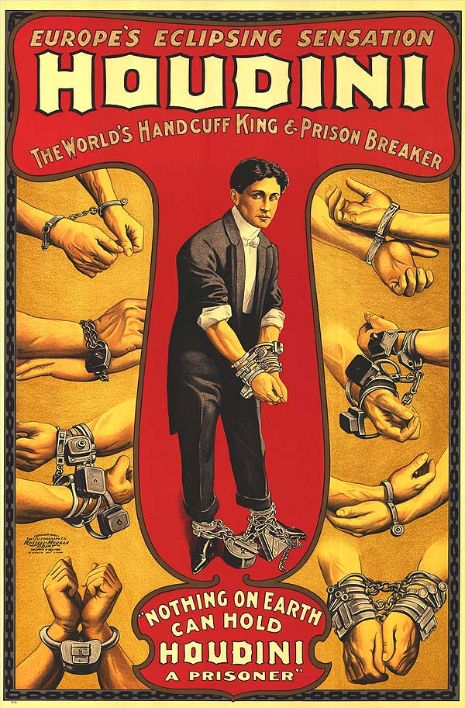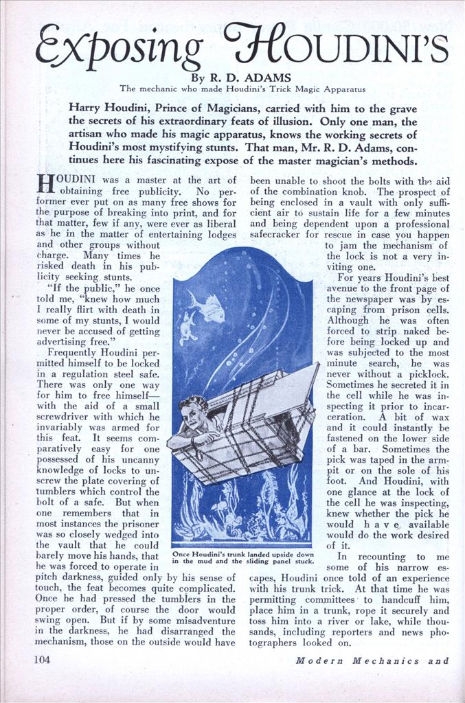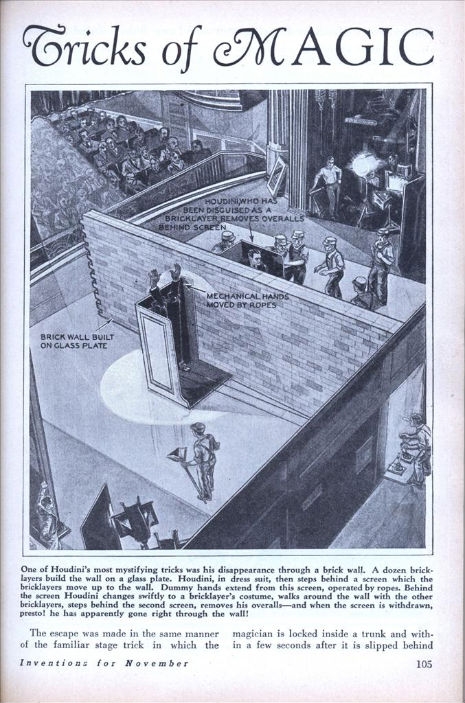
Harry Houdini is one of my heroes, I’ve admired the Great Mystifier from early age watching him on old flickering, hand-cranked black and white film clips, as he escaped from chains and tightly-bound ropes in prison cells, and from deep-sunk, wooden boxes and padlocked milk churns. He was an inspiration to try my own imagined skills escaping wound clothes lines and knotted school ties, while my mischievous older brother timed me, remorselessly pummeled or tickled me, depending on his mood. The plan was to master handcuffs and I started collecting keys and quickly learned how to pick padlocks and door locks.
Unlike today, where information is merely a click away, I honed-up on my heroes from books that came via a mobile library every Friday, and learned to memorize favorite programs and films when screened on TV—this was much easier when there were only two channels on British television, and nothing other than the one children’s show Watch With Mother during the day, which explains why watching television was a major event, and its impressions have lasted longer than some of the shows viewed since. When the Tony Curtis and Janet Leigh movie of the great Houdini was screened one Christmas, it only convinced me further that the man born Erik Weisz in Budapest in 1874 was the world’s greatest performer, illusionist and escapologist. That Houdini often dared his life to entertain, and in later years was the scourge of fraudulent clairvoyants and mediums, only adds to his reputation.
Finding these pages “Exposing Houdini’s Tricks of Magic,” from Modern Mechanix November 1929, brought me back to that delight and child-like wonder that Houdini’s magic inspires. Here you’ll find how a sliding panel helped Houdini escape from a submerged wooden trunk, how he used a jack to escape from a buried coffin, and his use of false arms to trick an audience of his whereabouts.
The article was penned by R. D. ADAMS, the mechanic who helped Houdini construct some of his illusions:
Houdini’s famed “disappearance through a brick wall” was one of his most widely applauded stunts. That it mystified the public is putting it mildly. Just a short time ago a leading scientific journal announced that the magician made his disappearance by means of a trapdoor on one side of the wall and came up through a similar channel on the other. That was wholly impossible. A trapdoor, regardless of how cleverly it had been constructed, would have been detected by the investigating committee. And besides to mystify his audience still further and demonstrate that a trapdoor was not used, a large sheet of paper and sometimes a sheet of plate glass was placed upon the floor of the stage and the brick wall built upon it. Passing through glass into trapdoors and vice versa was not possible even for the great man of mystery.
Here is how Houdini operated: A dozen or more bricklayers in overalls appeared before the audience and built a bona fide brick wall seven or eight feet high extending from the footlights to almost the rear of the stage. When it was completed, Houdini was ready to “disappear”. After a few appropriate remarks, he stepped behind a small screen, something like a prompter’s box, which the bricklayers pushed slowly to the center of the wall. The bricklayers moved over to the other side and adjusted a similar screen there opposite the first one. “Here I am, here I am,” Houdini would shout and waving arms thrust through holes in the screen gave evidence of the fact.
Then the arms would disappear and Houdini would step forth from the screen on the other side of the wall.
Houdini disappeared through the wall only in the minds of the exceedingly gullible. As a matter of fact while the first screen, behind which he had stepped, was being pushed back against the wall, he leaped into a pair of blue jumpers and pulled a workman’s cap down far over his face. When the screen touched the wall, he was one of the bricklayers as far as the audience was concerned. He got behind the second screen disguised as a bricklayer. From this point he did his calling to the audience. Mechanical arms and hands, operated by a hidden rope leading to the wings, furnished the gestures which convinces Houdini was behind screen No. 1 instead of No. 2 completing the illusion.
Read the entire article at Modern Mechanix.


This is an interesting documentary on Houdini, though I must point out that the Great Mystifier was not the first man to fly an airplane in Australia, that was Colin Defries; and although J. Gordon Whitehead delivered several blows to Houdini’s abdomen, a later blow, delivered by an unknown assailant at the Prince of Wales hotel in Detroit was the blow that probably killed the great man—he was sitting reading a newspaper when he was punched, and Houdini reportedly said, “You shouldn’t have done that.”. This has led to the suggestion Houdini was murdered by supporters of the (fraudulent) clairvoyants he had successfully debunked.
Via Modern Mechanix